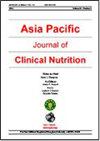新加坡家庭肠外营养的长期临床结果。
IF 1.3
4区 医学
Q4 NUTRITION & DIETETICS
Asia Pacific journal of clinical nutrition
Pub Date : 2023-01-01
DOI:10.6133/apjcn.202306_32(2).0011
引用次数: 0
摘要
背景与目的:家庭肠外营养(HPN)是慢性肠衰竭患者的一种维持生命的治疗方法。亚洲HPN患者的预后报道很少。我们的目的是回顾成人和儿科HPN患者的临床结果,我们的队列满足95%的新加坡HPN患者。方法和研究设计:这是一项来自新加坡最大的三级PN中心的成人(2002-2017)和儿科队列(2011-2017)HPN患者的回顾性研究。回顾了患者人口统计学和临床结果。结果:成人41例,小儿8例。成人平均年龄53.0(±15.1)岁,儿科平均年龄8(±1.8)岁。HPN的平均持续时间分别为2.6(±3.5)年和3.5(±2.5)年。成人HPN的主要适应症为短肠综合征(SBS) (n=19,46.3%)、机械性梗阻(n=9,22.0%)和胃肠运动障碍(GID) (n=5,12.2%)。13名成年患者(31.7%)有潜在的恶性肿瘤,7名(17.3%)接受姑息性HPN治疗。儿童患者中HPN的适应症为GID (n=5,62.5%)和SBS (n=3,37.5%)。中心线相关血流感染(CLABSI)/1000导管日分别为1.0(±2.1)和1.8(±1.3)。导管相关静脉血栓形成(CAVT)/1000导管日分别为0.1(±0.4)和0.7(±0.8)。生化性肠衰竭相关肝病(IFALD)分别为21.9%和87.5%。成人中位总生存期为90个月(4.3175.7,95%CI),精算生存期为70.7%(1年)和39.0%(5年)。成年恶性肿瘤患者的中位生存期为6个月(4.2,7.7,95%CI),精算生存期为85.7%(3个月)和30.7%(1年)。1例成人患者死于PN相关并发症。没有注意到儿童死亡。结论:虽然患者人数不多,但我们报告的成人和儿科队列的并发症和生存率与其他国际中心相当。本文章由计算机程序翻译,如有差异,请以英文原文为准。
Long term clinical outcomes of home parenteral nutrition in Singapore.
BACKGROUND AND OBJECTIVES Home parenteral nutrition (HPN) is a life sustaining therapy for patients with chronic intestinal failure. Reported outcomes for Asian HPN patients are scarce. We aim to review the clinical outcomes of adult and paediatric HPN patients in our cohort which caters for 95% of Singaporean HPN patients. METHODS AND STUDY DESIGN This is a retrospective review of HPN patients from an adult (2002-2017) and paediatric cohort (2011-2017) from the largest tertiary PN centres in Singapore. Patient demographics and clinical outcomes were reviewed. RESULTS There were 41 adult and 8 paediatric HPN patients. Mean age was 53.0(±15.1) (adults) and 8(±1.8) years-old (paediatrics). Mean duration of HPN was 2.6(±3.5) and 3.5(±2.5) years. Leading indications for adult HPN were short bowel syndrome (SBS) (n=19,46.3%), mechanical obstruction (n=9,22.0%), and gastrointestinal dysmotility disorders (GID) (n=5,12.2%). Thirteen adult (31.7%) patients had underlying malignancy, with seven (17.3%) receiving palliative HPN. Indications for HPN amongst paediatric patients was GID (n=5,62.5%) and SBS (n=3,37.5%). Central line-associated bloodstream infection (CLABSI)/1000catheter-days was 1.0(±2.1) and 1.8(±1.3). Catheter associated venous thrombosis (CAVT)/1000catheter-days was 0.1(±0.4) and 0.7(±0.8). Biochemical Intestinal Failure Associated Liver Disease (IFALD) was found in 21.9% and 87.5%. For adults, median overall survival was 90-months (4.3,175.7,95%CI), with actuarial survival of 70.7%(1-year) and 39.0%(5-years). Median survival for adult patients with malignancy was 6-months (4.2,7.7,95%CI), actuarial survival of 85.7%(3-months) and 30.7%(1-year). One adult patient died from PN related complications. No paediatric deaths were noted. CONCLUSIONS Whilst patient numbers were modest, we report comparable complication and survival rates to other international centres in both our adult and paediatric cohorts.
求助全文
通过发布文献求助,成功后即可免费获取论文全文。
去求助
来源期刊
CiteScore
2.50
自引率
7.70%
发文量
58
审稿时长
6-12 weeks
期刊介绍:
The aims of the Asia Pacific Journal of Clinical Nutrition
(APJCN) are to publish high quality clinical nutrition relevant research findings which can build the capacity of
clinical nutritionists in the region and enhance the practice of human nutrition and related disciplines for health
promotion and disease prevention. APJCN will publish
original research reports, reviews, short communications
and case reports. News, book reviews and other items will
also be included. The acceptance criteria for all papers are
the quality and originality of the research and its significance to our readership. Except where otherwise stated,
manuscripts are peer-reviewed by at least two anonymous
reviewers and the Editor. The Editorial Board reserves the
right to refuse any material for publication and advises
that authors should retain copies of submitted manuscripts
and correspondence as material cannot be returned. Final
acceptance or rejection rests with the Editorial Board

 求助内容:
求助内容: 应助结果提醒方式:
应助结果提醒方式:


